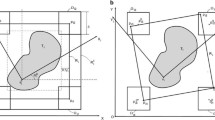Abstract
The article reviews the concept of and further develops phi-functions (Φ-functions) as an efficient tool for mathematical modeling of two-dimensional geometric optimization problems, such as cutting and packing problems and covering problems. The properties of the phi-function technique and its relationship with Minkowski sums and the nofit polygon are discussed. We also describe the advantages of phi-functions over these approaches. A clear definition of the set of objects for which phi-functions may be derived is given and some exceptions are illustrated. A step by step procedure for deriving phi-functions illustrated with examples is provided including the case of continuous rotation.
Similar content being viewed by others
References
Bennell, J. A., & Song, X. (2008). A comprehensive and robust procedure for obtaining the nofit polygon using Minkowski sums. Computers and Operational Research, 35(1), 267–281.
Burke, E. K., Hellier, R. S. R., Kendall, G., & Whitwell, G. (2007). Complete and robust no-fit polygon generation for the irregular stock cutting problem. European Journal of Operational Research, 179(1), 27–49.
Culberson, J. C., & Reckhow, R. A. (1988). Covering polygons is hard. In Proceedings of 29th IEEE conference on foundations of computer science (pp. 601–611).
Cunninghame-Green, R. (1989). Geometry. Shoemaking and the milk tray problem. New Scientist, 1677, 50–53.
Daniels, K., & Inkulu, R. (2001). Translational polygon covering using intersection graphs. In Proceedings of the thirteenth Canadian conference on computational geometry (pp. 61–64).
Daniels, K., Mathur, A., & Grinde, R. (2003). A combinatorial maximum cover approach to 2D translational geometric covering. In Proceeedings of 15th Canadian conference on computational geometry (pp. 2–5). Halifax, Nova Scotia, Canada, August 11–13, 2003.
Fomenko, A., Fuchs, D., & Gutenmacher, V. (1986). Homotopic topology. Akademiai Kiado: Budapest.
Ghosh, P. K. (1991). An algebra of polygons through the notation of negative shapes. CVGIP: Imag Understand, 17, 357–378.
Scheithauer, G., Stoyan, Y., Gil, N., & Romanova, T. (2003). Phi-functions for circular segments. Prepr. Technische Univarsitat Dresden, MATH-NM-7-2003. Dresden.
Stoyan, Y. (1983). Mathematical methods for geometric design. In Advances in CAD/CAM//. Proceeding PROLAMAT82. Leningrad, USSR, 16–18 May, 1982 (pp. 67–86). Amsterdam: North-Holland.
Stoyan, Y. (2003). Phi-function of non-convex polygons with rotations. Journal of Mechanical Engineering, 6(1), 74–86.
Stoyan, Y., & Gil, N. (1976). Methods and algorithms of placement of 2D geometric objects. Ukrainian SSR academy of sciences. Kiev: Naukova Dumka (In Russian).
Stoyan, Y., & Pankratov, A. V. (1999). Regular packing of congruent polygons on the rectangular sheet. European Journal of Operational Research, 113, 653–675.
Stoyan, Y., & Patsuk, V. N. (2000). A method of optimal lattice packing of congruent oriented polygons in the plane. European Journal of Operational Research, 124, 204–216.
Stoyan, Y., & Ponomarenko, L. D. (1977). Minkowski’s sum and the hodograph of the dense allocation vector function. Reports of the Ukrainian SSR Academy of Science, A(10), 888–890 (In Russian).
Stoyan, Y., Novozhilova, M., & Kartashov, A. (1996). Mathematical model and method of searching for a local extremum for the non-convex oriented polygons allocation problem. European Journal of Operational Research, 92, 193–210.
Stoyan, Y., Terno, J., Scheithauer, G., Gil, N., & Romanova, T. (2002a). Phi-functions for primary 2D-objects. Studia Informatica Universalis, 2(1), 1–32.
Stoyan, Y., Terno, J., Gil, M., Romanova, T., & Scheithauer, G. (2002b). Construction of a Phi-function for two convex polytopes. Applicationes Mathematicae, 29(2), 199–218.
Stoyan, Y., Scheithauer, G., Gil, N., & Romanova, T. (2004). Phi-functions for complex 2D-objects. 4OR (Operations Research): Quarterly Journal of the Belgian, French and Italian Operations Research Societies, 2, 69–84.
Stoyan, Y., Scheithauer, G., & Romanova, T. (2005a). Mathematical modeling of interaction of primary geometric 3D objects. Cybernetics and Systems Analysis, 41(3), 332–342. Translated from Kibernetika i Sistemnyi Analiz, 3, 19–31.
Stoyan, Y., Gil, N., Scheithauer, G., Pankratov, A., & Magdalina, I. (2005b). Packing of convex polytopes into a parallelepiped. Optimization, 54(2), 215–235.
Toth, G. F. (1997). Packing and covering. In J. Goodman & J. O’Rourke (Eds.), Handbook of discrete and computational geometry. New York: CRC Press.
Author information
Authors and Affiliations
Corresponding author
Rights and permissions
About this article
Cite this article
Bennell, J., Scheithauer, G., Stoyan, Y. et al. Tools of mathematical modeling of arbitrary object packing problems. Ann Oper Res 179, 343–368 (2010). https://doi.org/10.1007/s10479-008-0456-5
Published:
Issue Date:
DOI: https://doi.org/10.1007/s10479-008-0456-5




